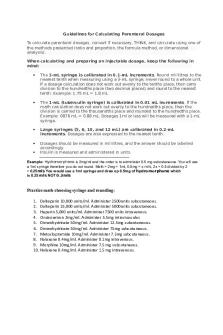Calculating Biodiversity Lab PDF

| Title | Calculating Biodiversity Lab |
|---|---|
| Author | Joop Miller |
| Course | biology |
| Institution | National University (US) |
| Pages | 3 |
| File Size | 202.8 KB |
| File Type | |
| Total Downloads | 57 |
| Total Views | 178 |
Summary
Calculating Biodiversity Lab...
Description
Calculating Biodiversity Lab Background Measuring biodiversity is an excellent way to determine an ecosystem’s overall health. In this lab, you will collect macroinvertebrates in a virtual stream ecosystem and use the data to determine the stream’s biodiversity as a function of water quality. Virtual Lab Link: http://virtualbiologylab.org/NetWebHTML_FilesJan2016/StreamDiversityModel.html
Procedure 1. Leave the settings as they are and click “Go” to begin the stream’s flow. 2. Then click “Open Seine”. 3. Let the simulation run until the collection time is complete. You can adjust the speed bar at the top as needed.
4. When the simulation is complete, take note of the number of total species caught as well as the total catch. Record both numbers in the first row of the data table where pollution level is “severe”. 5. Click “Reset” and change the pollution level to “moderate”. 6. Repeat steps 2-4 and record data points in the next row of the table labeled “moderate”. 7. Finally, click “Reset” and change the pollution level to “none”. 8. Repeat steps 2-4 and record data points in the next row of the table labeled “none”.
Collection Results Species Diversity – No Pollution Caddisfly
Mayfly
Stonefly
11 2 7 Dragonfly Crayfish Sowbug 8 6 3
Rif. Beetle 1
W. Penny 5
Worm 4
Gill Snail Dobsonfly 0
Blackfly 2
3 Midge
4
Leech 3
Cranefly 4 Lung Snail 5
Species Diversity – Moderate Pollution Caddisfly
Mayfly
Stonefly
0 3 0 Dragonfly Crayfish Sowbug 6 9 3
Rif. Beetle 2
W. Penny 0
Worm 6
Gill Snail Dobsonfly 0
Blackfly 3
3 Midge
3
Leech 8
Cranefly 4 Lung Snail 18
Species Diversity – Severe Pollution Caddisfly Mayfly Stonefly 0 0 0 Dragonfly Crayfish Sowbug 4 8 4
Rif. Beetle W. Penny Gill Snail Dobsonfly Cranefly 0 0 0 3 4 Worm Blackfly Midge Leech Lung Snail 37 14 1 3 10
Data biodiversity index=
total species total catch
Pollution Level
Total Species
Total Catch
9
Severe
Moderate
15
None
14
68
Biodiversity Index
0.088
75
72
0.2
0.19
Analysis Questions 1. In your own words, describe a biodiverse ecosystem. Biodiversity is the changeability among living life forms from all sources, including marine, and other oceanic biological systems and the natural edifices of which they are part; this incorporates variety inside species, among species, and of environments. 2. A biodiversity index ranges from zero to one. What does a higher biodiversity index likely indicate regarding the health of an ecosystem? More pollution
3. Why might water quality affect a stream’s biodiversity? Water pollution makes river biodiversity more vulnerable to climate warming. ... The breakdown of organic pollutants such as sewage and farm run-off uses oxygen, meaning that polluted waterways often suffer severe drops in dissolved oxygen levels....
Similar Free PDFs

Calculating Biodiversity Lab
- 3 Pages

Conservation of Biodiversity
- 6 Pages

Fundi Biodiversity Webquest
- 45 Pages

Calculating uncertaincy
- 3 Pages

Studoc envr biodiversity
- 2 Pages

Biodiversity under threat
- 8 Pages

Chapter 16 - Biodiversity
- 1 Pages

Enscie Sustaining Biodiversity
- 7 Pages

BIO280r8 Biodiversity Worksheet
- 3 Pages

Unit 1 - Biodiversity - Notes
- 20 Pages
Popular Institutions
- Tinajero National High School - Annex
- Politeknik Caltex Riau
- Yokohama City University
- SGT University
- University of Al-Qadisiyah
- Divine Word College of Vigan
- Techniek College Rotterdam
- Universidade de Santiago
- Universiti Teknologi MARA Cawangan Johor Kampus Pasir Gudang
- Poltekkes Kemenkes Yogyakarta
- Baguio City National High School
- Colegio san marcos
- preparatoria uno
- Centro de Bachillerato Tecnológico Industrial y de Servicios No. 107
- Dalian Maritime University
- Quang Trung Secondary School
- Colegio Tecnológico en Informática
- Corporación Regional de Educación Superior
- Grupo CEDVA
- Dar Al Uloom University
- Centro de Estudios Preuniversitarios de la Universidad Nacional de Ingeniería
- 上智大学
- Aakash International School, Nuna Majara
- San Felipe Neri Catholic School
- Kang Chiao International School - New Taipei City
- Misamis Occidental National High School
- Institución Educativa Escuela Normal Juan Ladrilleros
- Kolehiyo ng Pantukan
- Batanes State College
- Instituto Continental
- Sekolah Menengah Kejuruan Kesehatan Kaltara (Tarakan)
- Colegio de La Inmaculada Concepcion - Cebu





